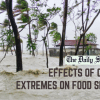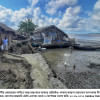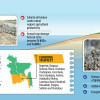Rising Sea Levels: 9 lakh in south may be displaced by 2050

Sea level rise may displace almost nine lakh people from southern Bangladesh by 2050, because their homes and livelihood will be jeopardised.
By the end of the century, the situation will be even worse as between 12 percent and 18 percent of Bangladesh's coastal area is projected to be submerged by rising seas, says a report released yesterday by the International Centre for Climate Change and Development (ICCCAD).
This will have devastating consequences for vital food crops, and more people will be forced to leave their homes, adds the report titled Climate Change Impacts in Bangladesh.
Currently, the estimated annual average loss due to cyclones is $1 billion, which is 0.7 percent of the GDP.
"Due to our country's geographical position, we are witnessing flooding, depletion of water sources, rising sea levels, and the intrusion of salinity. Projections indicate that millions, perhaps 1/7 of the population, might face displacement as per the World Bank's estimations," Saber H Chowdhury, minister for environment, forest and climate change, was quoted as saying in the report.
Sea level rise is projected to lead to a 6-9 percent decline in the country's rice production. Increasingly saline waters are also projected to disrupt fisheries, which will disproportionately affect poor coastal communities, for whom fish is an important source of protein.
Saline water can also infiltrate groundwater and surface water sources, affecting drinking water supplies and human health.
"Sea level around South Asia will continue to rise over the 21st century, increasing flooding in low-lying Bangladesh. This will devastate vital food crops, forcing more people to leave their homes," says professor AKM Saiful Islam, director of the Institute of Water and Flood Management (IWFM) of Buet and a lead author of the report.
The accelerating impacts of climate change in Bangladesh highlights an urgent need to scale up international action against climate change.
Bangladesh repeatedly experiences extreme climate events like heatwaves and tropical cyclones, the report adds.
In 2019 and 2000, the country experienced 185 extreme weather events, making it the seventh most vulnerable to climate change in the world.
Government adaptation policy and local initiatives have saved many lives and, so far, averted the worst impacts of climate change, the report says.
Bangladesh is recognised as a global leader in adaptation and resilience. In 2005, Bangladesh was one of the first least developed countries to develop a national adaptation programme of action.
By the end of the century, even under a very low emissions scenario, Bangladesh could see a further 0.8°C of warming compared with 1981–2010, and heavier rainfall could increase peak river flow by 16 percent relative to 1971–2000.
In the last few decades, the number of people who have died during cyclones has fallen from six digits (300,000+ from Cyclone Bhola in 1970) to double digits (35 from Cyclone Sitrang in 2022), largely due to the success of the country's Cyclone Preparedness Programme.
In the last few decades, the government has invested in saline-tolerant rice varieties, floating agriculture in regions that suffer flooding, and water-saving technologies in drought-prone areas to help safeguard food security in the face of increasingly extreme weather.

 For all latest news, follow The Daily Star's Google News channel.
For all latest news, follow The Daily Star's Google News channel. 








Comments